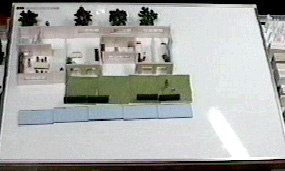 |
|
 |
|
< Analysis using ILP system > # Input # # Output # |
|
< Rules of space composition process > Rule1: Rule2:ハ |
 |
|
 |
|
< Analysis using ILP system > # Input # # Output # |
|
< Rules of space composition process > Rule1: Rule2:ハ |
Title:
Author(s):
NORITOSHI SUGIURA, SHIGEYUKI OKAZAKI
Publication/Publisher:
John S. Gero and Fay Sudweeks (eds.), Artificial
Intelligence in Design '02, Kluwer Academic Publishers, July
2002
Abstract:
In this paper, we summarized an application of the ILP technique
to the analysis of the human design process in architectural design.
We focused particularly on discovering the patterns in the spatial
composition process in the framework of design analysis called
Architectural Space Montage Technique. Spatial composition data
used in this paper are complexly structured data, which are collections
of architectural objects with geometric relationships. The objects
and relationships are constrained within a given set of attributes
(such as object type, object angle, time stamp, relation type)
together with background knowledge on the class hierarchies of
object types and re-lation types. We modeled these spatial composition
process data in first-order logic and applied the ILP system Progol
to discover design patterns that characterized the given data.
Author(s):
SUGIURA Noritoshi, OKAZAKI Shigeyuki
Publication/Publisher:
Journal of Archit. Plann. Environ. Engng. AIJ,
No.546, Aug, 2001
Abstract:
The latent rules of space composition process in the experiment
of Architectural Space Montage Technique (ASMT) was extracted
by Inductive Logic Programming (ILP: one of machine learning methodology).
The process of miniature disposition in ASMT is described as 5
attributes of miniatures: kind, direction, position, difference
in order of disposition and geometric binomial relation, which
is expressed in first order predicate logic. Four results of experiment
of ASMT were analyzed by ILP. And the peculiar rules extracted
in each experiment were L-shaped enclosure, composition with detached
miniatures, lengthwise parallel, composition with mat, respectively.
Title:
Author(s):
SUGIURA Noritoshi, HOZUMI Teruaki, OKAZAKI
Shigeyuki, YANAGISAWA Kazuhiko
Publication/Publisher:
Summaries of technical papers of Annual Meeting
Architectural Institute of Japan, 1999
Abstract:
When man designs an architectural space, he
refers some patterns about attributes of constituent elements
and geometric relation between constituent elements. Usage of
the patterns makes a style of the designer and spatial characteristics. As
man learns the patterns through experience and training, it is
difficult to express by words. In this paper, we applied a machine
learning methodology called Inductive Logic Programming(ILP) and
proposed a system that extracts latent patterns objectively from
space composition process on Architectural Space Montage Technique. By
this system, we can get some rules correspond to characteristics
felt intuitively through clinical observation.
Title:
Author(s):
SUGIURA Noritoshi, OKAZAKI Shigeyuki, YANAGISAWA
Kazuhiko, HOZUMI Teruaki
Publication/Publisher:
Summaries of technical papers of Annual Meeting
Architectural Institute of Japan, 1999
Abstract:
In this paper, we applied a machine learning
methodology called Inductive Logic Programming(ILP) and proposed
a system which extracts latent patterns objectively from space
composition process on Architectural Space Montage Technique. We
have conducted experiments with schizophrenic patients, and extracted
some rules about placement of miniatures from composition process
of two examples, which looks to be similar. We examined whether
extracted rules express spatial characteristics common to both
examples. We could get some rules by the system partly common
to both examples. And from extracted rules, some latent differences
between similar examples were found.
Title:
Author(s):
SUGIURA Noritoshi, OKAZAKI Shigeyuki, SUGAI
Shigeyoshi
Publication/Publisher:
Summaries of technical papers of Annual Meeting
Architectural Institute of Japan, 2000
Abstract:
Title:
Author(s):
SUGIURA Noritoshi, OKAZAKI Shigeyuki, SUGAI
Shigeyoshi
Publication/Publisher:
Summaries of technical papers of Annual Meeting
Architectural Institute of Japan, 2000
Abstract:
Author(s):
SUGIURA Noritoshi, OKAZAKI Shigeyuki
Publication/Publisher:
Summaries of technical papers of 45th Annual
Meeting Japanese Society for Artificial Intelligence, 2001
Abstract:
In this paper, we summarize an application of ILP technique
to the analysis of human design process in the domain of architechtural
design. We forcuse partcularly on the discovering patterns in
spacial composition process in a context of an framework of design
analysis, called Architectural Space Montage Technique. Spacial
composition data used in this paper are complexly structured data,
which are collections of architechtural objects with geometric
relationships. We model these spacial composition process data
in first-order logic and apply an ILP system Progol to discover
design patterns that characterize the given data.